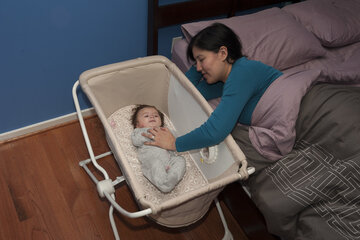
Why Baby Arching Back When Feeding
When babies arch their back during feeding, it can be alarming for parents. However, this behavior is relatively common and can occur for several reasons. Understanding the potential causes can help ease concerns and guide you on effectively responding.
Gastroesophageal Reflux (GERD)
One of the most common reasons for back arching is gastroesophageal reflux disease (GERD). GERD happens when stomach contents, including acid, flow back into the esophagus, causing discomfort.
Babies experiencing GERD may arch their back to relieve this discomfort, which is often accompanied by spitting up or excessive crying.
If you suspect GERD, consult with a pediatrician who may suggest strategies like adjusting feeding positions or prescribing medications.
Gas or Digestive Discomfort
Another frequent cause of Baby Arching Back When Feeding is gas or bloating in the digestive system. Babies may experience discomfort from trapped air or gas bubbles, and arching their back can help alleviate the pressure.
Burping your baby during and after feeds, along with gently massaging their tummy, may help relieve this type of discomfort.
Normal Developmental Reflex
Back arching can also be part of a baby’s natural developmental reflexes. As babies grow, they begin to explore different movements,
and arching their back can indicatethe development of stronger muscles. This is typically harmless and may signal readiness for milestones like rolling over or sitting up.
Understanding Newborn Communication

Newborns are not able to speak, but they communicate with you in many ways. As parents and caregivers, it’s important to understand their cues, cries,
and body language to respond to their needs effectively. By tuning into your baby’s signals, you can build a deeper bond and help them feel safe and secure.
1. Crying – The Most Common Form of Communication
Crying is a newborn’s primary way of signaling their needs. While all babies cry, the reasons behind the crying can vary, and over time, you will begin to understand your baby’s unique cry. Some common reasons babies cry include:
Hunger: A short, rhythmic cry often means your baby is hungry and needs to be fed.
Discomfort: A higher-pitched or more frantic cry might indicate that your baby is uncomfortable, possibly due to a wet diaper or tight clothing.
Tiredness: Sometimes babies cry when they are overtired or need help falling asleep.
Pain or Illness: A different, more intense cry might suggest pain or discomfort, such as from colic or an ear infection.
As your baby grows, you’ll begin to recognize the different types of cries and how to respond.
2. Body Language and Movements
Even newborns communicate through their body language. Some common signs include:
Fisting hands: A baby who clenches their hands tightly might be feeling stressed or hungry.
Arching the back: This can be a sign of discomfort, reflux, or overstimulation.
Turning head: When a baby turns their head to the side, they may be seeking comfort or food.
Mouthing or sucking: Babies have a strong instinct to suck, which can indicate hunger, self-soothing, or the need to explore their environment.
Paying attention to these physical cues helps you meet your baby’s needs before they escalate into crying.
Why is My Baby Arching Her Back While Breastfeeding?
If you notice your baby arching her back while breastfeeding, it can be concerning, but there are several common reasons behind this behavior.
Understanding why this happens can help you determine if it’s part of normal development or if it’s a sign of discomfort.
1. Discomfort from Gastroesophageal Reflux (GERD)
One of the most frequent causes of back arching during breastfeeding is gastroesophageal reflux (GERD). This condition occurs when stomach acid moves back into the esophagus, causing discomfort or even pain.
Babies with GERD may arch their back as a way to cope with the discomfort. Other signs of GERD include excessive spitting up, irritability, or crying after feeds.
If you suspect your baby has GERD, consult your pediatrician for guidance on treatment options.
2. Gas or Digestive Issues
Babies’ digestive systems are still developing, and they may experience gas or bloating during or after a feed, which can lead to discomfort.
Arching their back may help relieve the pressure caused by trapped air. To help alleviate this discomfort, ensure that your baby is burped frequently during and after each feed.
What to Do When Baby is Arching Back While Nursing

It can be distressing when your baby arches their back while nursing, but understanding why this happens and knowing how to respond
can help make feeding time more comfortable for both of you. Here are some steps you can take if your baby is arching their back during breastfeeding.
1. Check for Discomfort from Gas or Bloating
Sometimes babies arch their back due to gas or digestive discomfort. To help relieve this:
Try different feeding positions, such as holding your baby more upright, to reduce pressure on their stomach.
Massage your baby’s tummy gently to help move gas bubbles along.
2. Adjust Feeding Positions
Experiment with different breastfeeding positions to find one that works best for you both. A common position that helps with reflux
and discomfort is the laid-back breastfeeding position or reclining position, where you lean back slightly and allow your baby to latch in a more natural, relaxed way.
3. Address Potential Reflux (GERD)
If your baby is arching their back frequently while nursing and you suspect reflux, this could be a sign of gastroesophageal reflux disease (GERD). GERD occurs when stomach acid flows back into the esophagus, causing discomfort.
If you think this is the case, consult your pediatrician. They may suggest feeding your baby in an upright position, thickening breast milk or formula (under medical guidance), or medications to manage reflux symptoms.
4. Ensure a Calm Environment
Sometimes babies arch their back as a reaction to overstimulation or discomfort from their surroundings. Make sure the environment is calm and quiet, with minimal distractions, so your baby can focus on feeding.
5. Check for Hunger Cues or Overfeeding
Babies may arch their back if they are frustrated due to hunger or if they are overwhelmed by too much milk.
Ensure your baby is showing clear hunger cues before starting a feed. If you suspect overfeeding, try paced bottle feeding or allowing your baby to nurse more slowly to avoid gorging.
6. Give It Time and Monitor Development
In many cases, back arching during breastfeeding is simply part of your baby’s normal developmental reflexes. As babies grow, they develop strength and coordination, and they may explore new movements, including arching their back.
If your baby seems comfortable otherwise and isn’t in pain, this behavior may be a sign of motor development.
If back arching continues, is associated with pain, or affects your baby’s feeding habits, don’t hesitate to consult with your pediatrician to ensure everything is okay.
Is Back Arching Normal in Babies?

Yes, back arching is often a normal part of a baby’s development. In many cases, it is a natural movement as your baby learns to control their body and strengthen their muscles.
However, it can also indicate discomfort, overstimulation, or, in some cases, an underlying medical issue. Understanding when back arching is normal and when it might require attention is key.
When Back Arching is Normal
Back arching is a common reflex as babies develop motor skills. It helps strengthen the muscles in their back, neck, and core, which are essential for rolling, sitting,
and crawling. This type of arching often happens during tummy time, playtime, or when your baby is stretching.
Self-Soothing
Some babies arch their backs as a form of self-soothing, especially during transitions like falling asleep or after waking up.
Expressing Emotions
Babies may arch their backs to communicate frustration, discomfort, or excitement. For example, they might do this during a tantrum or when they are overstimulated.
When Back Arching May Be a Concern
If your baby arches their back excessively or with great intensity, especially during feedings, it could signal discomfort or a condition like gastroesophageal reflux (GERD).
Signs of Pain or Distress
If back arching is paired with crying, grimacing, or other signs of distress, it might indicate an issue such as gas, colic, or food intolerance.
Associated with Developmental Delays
Back arching that accompanies unusual muscle tone, delayed milestones, or rigidity could suggest a neurological or muscular concern, such as cerebral palsy or hypertonia.
During Seizure-Like Activity
In rare cases, back arching could occur during a seizure or spasm. This is typically accompanied by other abnormal movements or unresponsiveness.
Why Your Baby is Arching Their Back
When your baby arches their back, it can be concerning, especially if it happens frequently or during specific activities like feeding. However, this behavior is relatively common and can be attributed to several different causes.
Understanding why your baby is arching their back will help you respond appropriately and ensure they are comfortable.
Discomfort or Pain (Reflux)
One of the most common reasons babies arch their back is to relieve discomfort or pain, particularly from gastroesophageal reflux (GERD). GERD occurs when stomach acid flows back into the esophagus, causing a burning sensation.
Babies with GERD may arch their back during or after feeding in an attempt to relieve the discomfort. This can be accompanied by other signs such as excessive crying, spitting up, or irritability.
If you suspect your baby has GERD, it’s important to consult your pediatrician for guidance on treatment or feeding adjustments.
Gas or Digestive Issues
Another frequent reason for back arching is gas or digestive discomfort. Babies are still developing their digestive systems,
and they may experience gas or bloating during or after feedings. Arching their back can be a way to help relieve the discomfort caused by trapped air.
Ensuring your baby is burped regularly during and after feeding can help reduce this discomfort. In some cases, gentle tummy massages or changing feeding positions may also provide relief.
When to Seek Help
In most cases, back arching is a normal part of your baby’s development, or it may be caused by something like gas or reflux. However, if the behavior is severe, frequent, or accompanied by signs of pain, discomfort, or developmental concerns,
it’s important to speak with your healthcare provider. They can help identify any underlying issues and suggest strategies to help your baby feel more comfortable.
Solutions & Treatments for Back Arching in Babies
If your baby frequently arches their back, identifying the cause is essential for finding the right solutions or treatments. While many instances of back arching are normal and temporary,
some may require medical attention. Below are effective strategies to address backarching based on its potential causes.
Address Gastroesophageal Reflux (GERD)
GERD is a common reason for Baby Arching Back When Feeding, especially during or after feedings. To reduce
Feed in an upright position: Keep your baby upright during and for 20–30 minutes after feeding to help prevent stomach contents from flowing back into the esophagus.
Smaller, more frequent feeds: Overfeeding can worsen reflux. Offering smaller portions more frequently may ease symptoms.
Consult a pediatrician: In severe cases, medications or dietary changes might be recommended to manage GERD symptoms.
Ease Gas and Digestive Discomfort
Babies may arch their back due to gas or bloating. To alleviate this:
Burp frequently: Burp your baby during and after feeds to release the trapped air.
Gentle tummy massage: Use circular motions on your baby’s tummy to ease bloating.
Tummy time: Supervised tummy time can help move gas through the digestive system and strengthen muscles.
Adjust feeding techniques: Ensure your baby is latched correctly during breastfeeding or using a slow-flow bottle nipple to prevent swallowing air.
Adjust Feeding Positions
Positioning plays a key role in your baby’s comfort during feeding. If back arching occurs:
Try the laid-back position: Leaning back slightly while breastfeeding can help your baby latch more naturally and comfortably.
Hold your baby upright: Particularly useful for babies with reflux or feeding-related discomfort.
Experiment with side-lying nursing: This can be gentler for babies who seem overstimulated or restless.
When to Seek Medical Attention
If your baby’s back arching is persistent, severe, or associated with:
Poor feeding or weight gain.
Excessive crying or irritability.
Developmental delays.
Signs of pain, like grimacing or wincing.
Contact your pediatrician for a thorough evaluation. Early intervention ensures your baby’s comfort and supports healthy development.
By identifying the cause and applying these solutions, you can help your baby feel comfortable and supported, while also gaining peace of mind as a parent.
When to Call a Doctor

While back arching in babies is often harmless and a normal part of development, it can sometimes indicate an underlying issue that requires medical attention. Here’s a guide on when you should consider calling a doctor.
Persistent or Severe Back Arching
If your baby arches their back frequently or with significant intensity, especially when combined with other concerning behaviors, consult your pediatrician.
Persistent back arching could indicate conditions like gastroesophageal reflux disease (GERD), muscle tone issues, or other medical concerns.
Signs of Pain or Discomfort
Contact a doctor if back arching is accompanied by:
Crying that is intense, prolonged, or difficult to soothe.
Signs of discomfort during feeding, such as pulling away, grimacing, or excessive spitting up.
Arching that seems to be a response to pain or distress.
Feeding or Weight Gain Issues
If your baby is struggling to feed effectively or is not gaining weight as expected, back arching could be a symptom of an underlying feeding or digestive issue, such as reflux or food allergies.
When to Seek Emergency Care
Your baby is arching their back and appears to have difficulty breathing.
They are unresponsive or excessively drowsy.
You suspect a seizure, characterized by stiffening and jerking movements.
Trust Your Instincts
As a parent, you know your baby best. If you feel that your baby’s behavior is unusual or concerning, don’t hesitate to call your pediatrician. Early evaluation and intervention can provide reassurance and ensure your baby’s comfort and health.


Leave a Comment